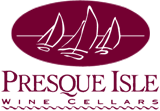Shop by Category
- Our Winery Story
- Wine Catalog
- Where We Can Ship Wine - 40 STATES!
- Join Our Wine Club
- Wine Quick Order Form
- Special Wine Packages
- See All Our Wines
- The Kisses Ice Style Wines
- 90+ Point Wines
- Gold Medal Winners
- Lake Erie Sweet Wines
- Cider
- Bar Supplies
- Online Gift Shop
- Gift Certificates
- Our Vineyards
- Wine News and Awards
- WINE4GOOD
info_region-lake-erie-avaThe Lake Erie Viticultural Appellation was the first multi state Appellation to be approved, and covers the region along the south shore of the lake from Toledo, Ohio to Buffalo, NY on lands affected climatically by Lake Erie. Virtually every existing vineyard lies in the narrow band below the first ridge south of the lakeshore which is known locally by the French term 'escarpment'. This arrangement provides a unique micro climate where the large mass of lake water holds heat from the summer and moderates local temperatures and provides warm breezes through autumn to delay typical first frost into November and conversely the lake moderates winter low temperatures, but keeps the area cooler into the spring, delaying first budding until past the typical last frost date. The steep terrain below the escarpment also provides good cold air drainage. This is a somewhat similar situation to that of the Finger Lakes Region of New York state. In Erie County, where we are located, the escarpment lies closer to the Lake and is at its highest elevation of about 1500 ft, which is a rise of over 900 ft from the average Lake Erie elevation of 573 ft. As one goes either east or west the elevation of the escarpment is lower and farther from the lake and the frost free season is shorter and winter minimums can be lower. The only other portion of the Appellation with as long a growing season is the Lake Erie Islands (North Bass, Middle Bass, Kelley's) in Ohio. We have the greatest concentration of vineyards (acres per square mile) in the country after the Central Valley of California, albeit a long way below that region in acreage quantity, since California produces over 90% of the wine produced in the US. We have a 194 day average frost free season, and in the majority of winters don’t have sub-zero temperatures. We are relatively cool with average temperatures of 71°F in July and August. We have fewer problems with many of the fungal diseases because of the almost continuous breezes off the Lake. White wines greatly outnumber reds in the region, although several reds also do very well. Good ripeness can be reached by avoiding overcropping, and pH levels are low, which is a real plus in regard to longevity of the wines. Acidity can be high in poorer years (translation—less sunlight, more rain and colder weather). Most wines show good varietal fruit character and have fairly light tannins. Chardonnay, Riesling, Gewurztraminer and French hybrids like Vidal and Vignoles are whites that generally show well in the region as do Blaufrankisch (Lemberger), Dornfelder, Merlot, Cabernet Franc and French hybrids Noiret (NY 73) and Chambourcin as reds. Regionally such native Vitis labrusca grapes as Catawba, Niagara, Steuben and Delaware are used for whites and Fredonia and Concord for reds. These wines are typically very grapey, with strong fruit character carrying through, and are usually finished sweet with 4 to 8 percent residual sugar. SHOP OUR WINES LEARN ABOUT OUR BUSINESS |
